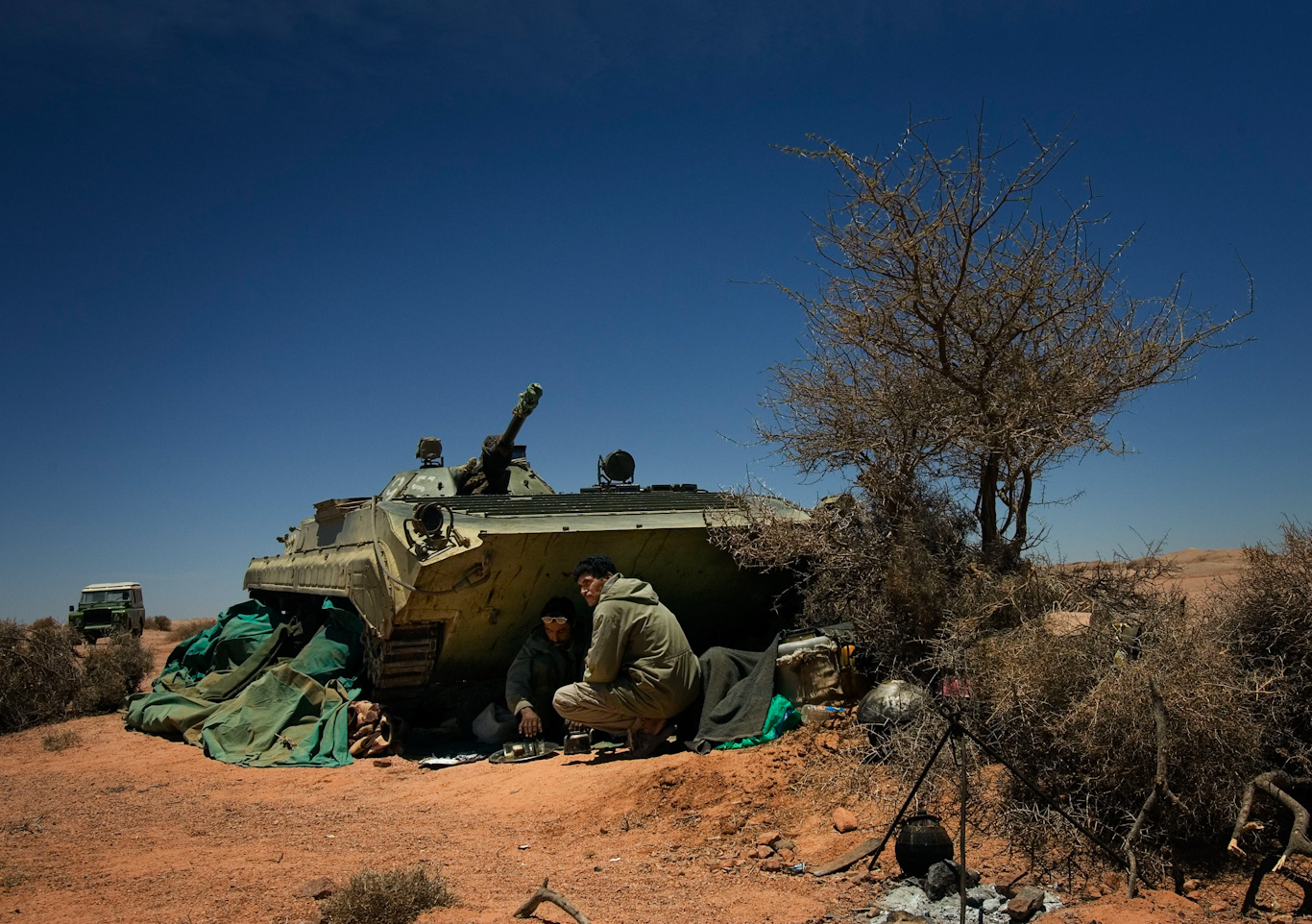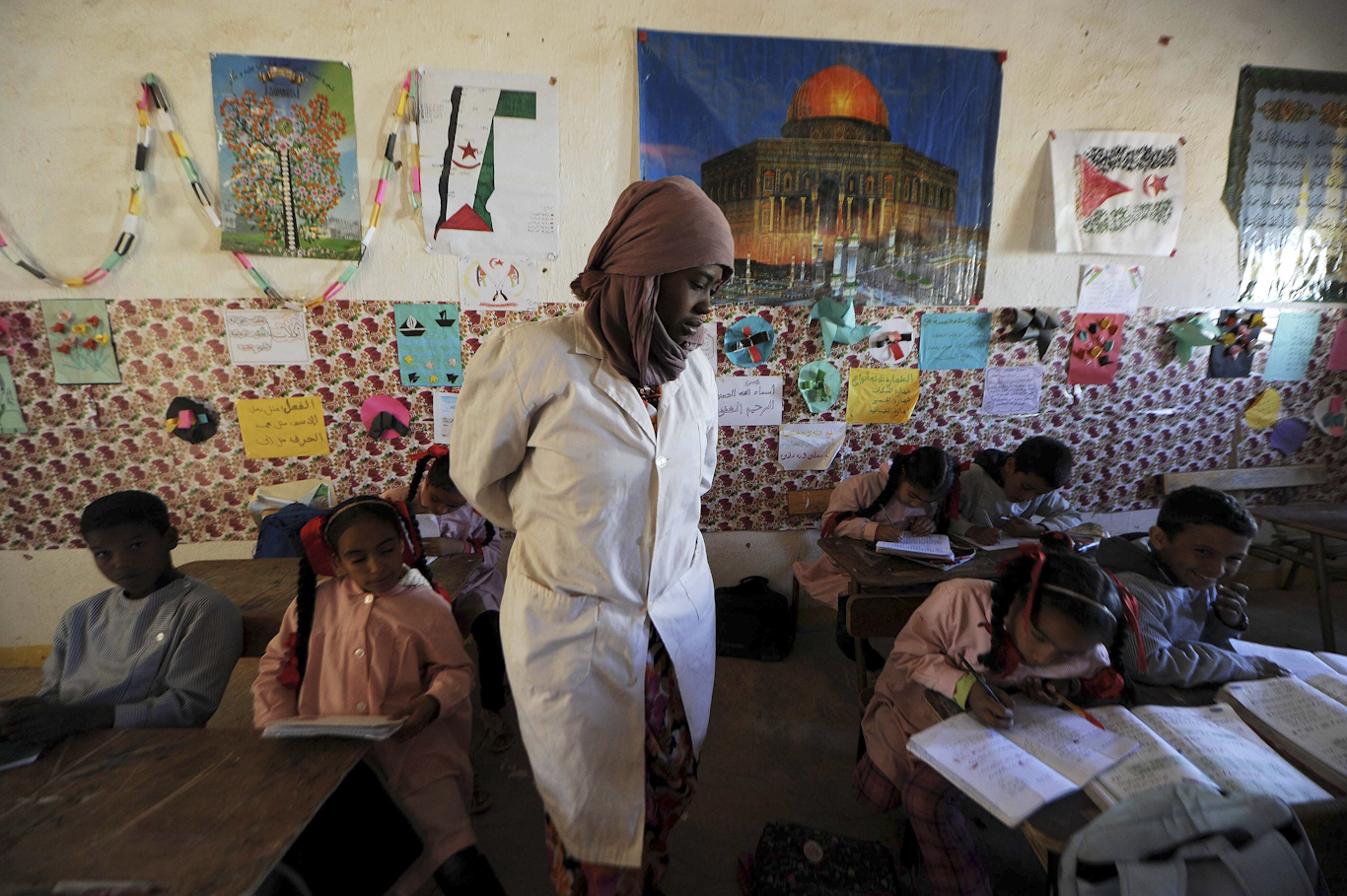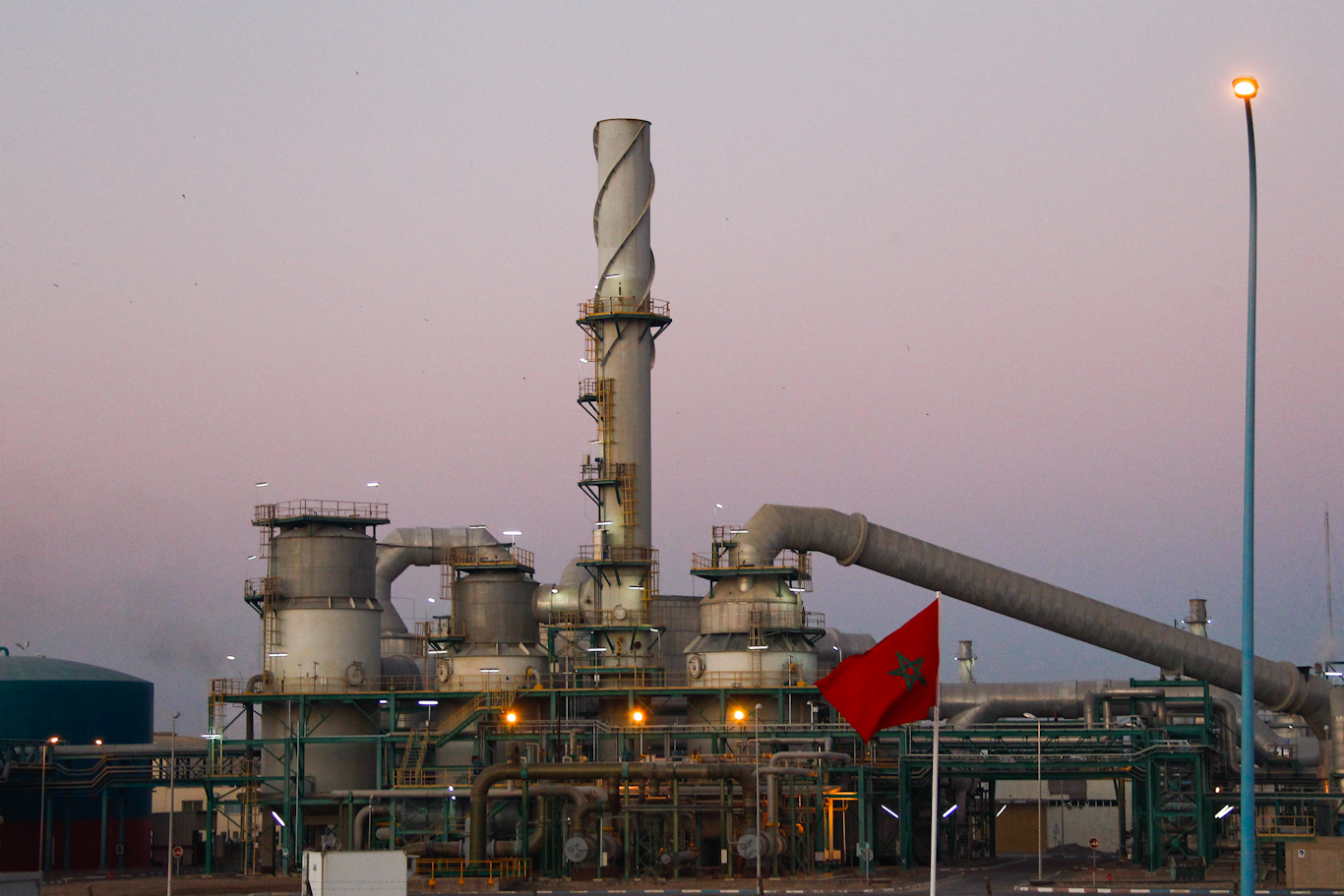WESTERN SAHARA — On November 13, 2020, commanders from the United States and Morrocan militaries met to plan annual joint exercises. The following day, 1,000 Moroccan soldiers and 200 vehicles stormed into the Guerguerat border crossing – a key highway in the occupied Western Sahara that connects Morocco to Mauritania, built in violation of international law.
The indigenous people, known as Sahrawis, had been staging daily protests in this demilitarized zone and blocking the road for three weeks prior. Though no one was injured in Morocco’s attack, it shattered a 29-year ceasefire and reignited an independence struggle in Africa’s last extant colony, Western Sahara.
After the Morrocan attack, the Sahrawi armed resistance group known as the POLISARIO Front evacuated the civilian protesters and returned fire. Since then, Sahrawi men and women enlisted in the resistance group have battled Moroccan forces, using aging weaponry from the Soviet Union.
The fog of war, the clarity of U.S. geopolitics
The Moroccan military doesn’t allow journalists to enter the occupied territory, creating a media blackout. The POLISARIO Front has provided videos of its military operations, but there is no information about casualties and family members of fighters have no way to contact them.
“I don’t know if my brothers are still alive, I don’t know if my family that lives there are alive. Because we don’t have that information, we don’t have any contact,” says Sahrawi refugee Nana Salem.
As the battle raged, then-President Donald Trump announced U.S. recognition of Morrocan sovereignty over the Western Sahara and that Morocco would follow the United Arab Emirates and Bahrain, and formally normalize relations with Israel. At the center of this effort was Jared Kushner.
“By recognizing Moroccan sovereignty over the Western Sahara, President Trump is rejecting the failed status quo, which benefits no one, and instead is driving toward a just, lasting, and mutually acceptable solution,” Kushner explained. But this mutual recognition of occupying states with expansionist ideologies is little more than a rebranding of a status quo that has long benefited Morocco, Israel and the United States.
A long struggle for independence
The territory of Western Sahara is the last settler-colony in Africa. Eighty percent of the territory is under Moroccan occupation and settlers now constitute two-thirds of the population of 500,000.
The Sahrawi struggle for independence predates Morrocan occupation. In 1884, Spain began to colonize the Western Sahara, referring to it as the Spanish Sahara and its inhabitants as the Sahrawis. In 1957-58 the Sahrawis began an uprising against Spain that formed a national consciousness. This was backed by international law: in 1972, UN Resolution 2983 affirmed “the inalienable right of the people of the Sahara to self-determination and independence.”

Polisario freedom fighters prepaare tea in the Western Sahara region of Tifariti, May 20 2008. Daniel Ochoa de Olza | AP
In the early 1970s, Sahrawi El-Ouali Mustapha Sayed, influenced by the revolutionary writer Franz Fanon, founded the POLISARIO front – an armed resistance group dedicated to ousting the U.S.-backed fascist dictator of Spain, Francisco Franco.
But Hassan The Second, the king of Morocco – which had gained independence from France and Spain in the 1950s – was weakened after two failed military coup d’etats. To bolster his nationalist credentials, Hassan looked to expand borders south as part of a Greater Morocco vision, setting up for a clash with Spain and international rulings.
In 1975, the United Nations Security Council issued a report in favor of the Sahrawi and independence, and the International Court of Justice issued an opinion against Moroccan and Mauritanian claims to the territory, signifying its status as the last colony of Africa.
Franco was on his deathbed and worried that a renewed colonial war in Africa would undermine his regime’s stability.
Swept up in the Cold War board game
For Washington, Morocco was an important Cold War ally essential to projecting anti-communist influence over the Mediterranean, Africa, and into southwest Asia. The former United States Ambassador to Morocco, Joseph Verner Reed Jr., remarked, “It is obvious that the next pressure point for the Soviets is going to be the Kingdom of Morocco, situated strategically as it is on the Straits of Gibraltar.” Thus Washington secretly arranged for the Spanish to withdraw from the Western Sahara and cede it to Morocco and Mauritania.
The United States and Saudi Arabia helped Morocco plan what is known as the Green March. King Hassan ordered 350,000 volunteers, flanked by military forces, to storm the Western Sahara, portraying an armed invasion as an act of liberation. The marchers carried Qurans as well as Moroccan, American and Saudi flags. While it’s called the Green March for the often-green-colored Qurans carried by marchers, some carried the red-white-and-blue American flag.
Moroccan soldiers acted with unrestrained brutality as they carried out a campaign of ethnic cleansing. Witnesses described widespread torture, rape, and murder. Forty thousand Sahrawi civilians fled to the interior of the territory. There they were attacked by Moroccan warplanes that fired napalm and white phosphorus. Others fled to safety in neighboring Algeria, where they built refugee camps.
Independence declared, battle continued
Defiant, El-Ouali Mustapha Sayed and the Sahrawis declared the independence of the Sahrawi Arab Democratic Republic. “In the name of God and with the help of God, to materialize the will of the Arab people, and in loyalty to our righteous martyrs and as a culmination of the sacrifices of our people, today on the land of Saguia el-Hamra and Oued Ed-Dahab the flag of the Sahrawi Arab Democratic Republic will be raised,” Sayed declared.

Sahrawi schoolchildren in the Smara refugee camp, Tindouf, Algeria, March 4, 2016. Toufik Doudou | AP
The POLISARIO front continued to battle the much larger militaries of Morocco and Mauritania, winning impressive successes. By 1979, Mauritania was forced into an agreement and withdrew. The POLISARIO – backed by Muammar Qaddafi’s Libya and Abdelaziz Bouteflika’s Algeria – continued to battle the U.S.- and EU-backed Moroccan forces.
While Israel and Morocco developed ties in secret and the Mossad helped stamp out Moroccan opposition movements, Palestinian revolutionary leader George Habash visited the Sahrawi refugees to declare support for their cause.
World’s longest military wall
In 1981, Morocco began construction of a 1,600-mile wall – the longest military barrier in the world – made of sand, loaded with sensors supplied by the U.S. and France, booby-trapped with millions of mines, and patrolled by tens of thousands of soldiers. This would prevent the return of the Sahrawi refugees in Algeria and cement Moroccan control of the majority of the territory.
In the wake of the Iranian revolution that ousted the U.S.-backed Shah, the Carter and Reagan administrations increased economic and military aid to prop up the king of Morocco, which was facing an internal crisis from importing food and energy, drought, and its expensive occupation. The two countries signed an agreement allowing the U.S. to use its military airbases. Washington saw this as a crucial step in projecting its influence.
In 1991, a United Nations peacekeeping mission brokered a ceasefire that was to be followed with a referendum on whether to join Morocco or become independent. But Moroccan intransigence and UN malfeasance prevented the referendum from ever taking place.
Raping the resources
Over the decades, the Moroccan settler population expanded while the United States and European Union have illegally exploited the Western Sahara’s resources, mining phosphates, fishing in its waters, and in recent years, drilling for oil and gas.
Phosphates are an essential ingredient in fertilizers for growing crops, and thus for agri-business, which has a major impact on U.S. policy. One analysis states that “U.S. phosphate supplies will run out within the next four decades, but Morocco has a supply of at least 300 years,” adding that “the issue has the potential to alter current appraisals of American strategic interests in the region.”
Perhaps even more valuable in the short term than Western Sahara’s mineral deposits are the fish in its coastal waters. But unregulated Moroccan and European fishing have depleted those stocks. An independent study commissioned by the European Union in 2011 found that Western Sahara’s fish supply had been decimated.

A Moroccan flag flies in front of a phosphate production facility in Jorf Lasfar. Abdeljalil Bounhar | AP
While Sahrawi refugees are forced to rely on pittances from the European Union, Morocco illegally sells their fish resources to foreign countries. Western Sahara Resource Watch found that “[t]he value of the exports of fishmeal from the occupied territory to Turkey, alone, equals three times the entire amount that is donated in multilateral aid to the refugees in one entire year… The EU today pays Morocco more to get access to Western Sahara’s fish banks than they give in aid to the refugees.”
What’s more, a document from the Moroccan Foreign Ministry leaked in 2014 revealed that Morocco strategically embroils other countries in its occupation in order to shield it from international law. The document proposed to “Implicate Russia in activities in the Sahara, as is already the case in the field of fisheries.… In return, Russia could guarantee a freeze on the Sahara file within the UN.” Indeed, the UN has stalled out time and time again in delivering any semblance of justice for the people of the Western Sahara.
A key outpost of Western imperialism
Nearly 50 years after its occupation of the Western Sahara began, Morocco remains a key outpost of Western imperialism in Africa. It’s a major non-NATO ally and hosts the African Lion and Phoenix Express exercises with the U.S. military.
Morocco is also a major recipient of American weapons. Ninety-one percent of its arms imports are from the United States. And in 2019, Morocco spent $10.3 billion dollars on U.S. weapons – more than any other country in Africa or the Middle East — and signed a ten-year military cooperation agreement with the Trump administration.
In some regards, Morocco’s occupation of the Western Sahara is a project of the United States. Moroccan military officers study at the U.S. Army War College and National Defense University in its International Military Education and Training program. The majority of these officers are deployed to the Western Sahara upon graduation, where they oversee an occupation regime dedicated to stamping out the Sahrawi national cause. Protests are met with brute force and severe beatings.
Morocco is also a partner in the secretive, U.S.-led Trans-Sahara Counterterrorism Partnership; yet its political, social and economic dynamic produces a disproportionate number of jihadists that have fought in Afghanistan, Syria, Bosnia and Chechnya, and carried out a series of bombings in Madrid in 2004.
The same geopolitical dynamic from the Cold War exists today. Morocco’s militarization has sparked an arms race for dominance of the skies with neighboring Algeria, which has been a long-time supporter of the POLISARIO and hosts Sahrawi refugees. In May 2020, Algeria agreed to purchase Russian weapons, cementing its status as the continent’s top importer of Russian military equipment.
Occupation and empty promises
For Sahrawis, decades of Moroccan occupation and empty promises from the international community have bred frustration and militancy. And the COVID-19 pandemic has made life in the refugee camps even more unbearable.
As for what the Biden administration might do, his secretary of defense, Ret. Gen. Lloyd Austin, was clueless when he was asked his opinion on the Western Sahara, responding: “Well, that’s an issue that I certainly would want to take a closer look at before I gave you a detailed answer. But it’s one of the things that I look at right away, if confirmed, going into the position.”
With little information coming out of the battle between Morrocan occupation forces and the POLISARIO front, only time will tell whether the Sahrawi struggle for independence will succeed and whether Morocco’s refusal to end its rule will spark a wider war.
Feature photo | Graphic by Antonio Cabrera
Dan Cohen is a journalist and filmmaker. He has produced widely distributed video reports and print dispatches from across Israel-Palestine. Dan is a correspondent at RT America and tweets at @DanCohen3000.
The post The Empire’s Hidden Hand: How The US Established, Sustains and Benefits From Morocco’s Occupation of Western Sahara appeared first on MintPress News.
